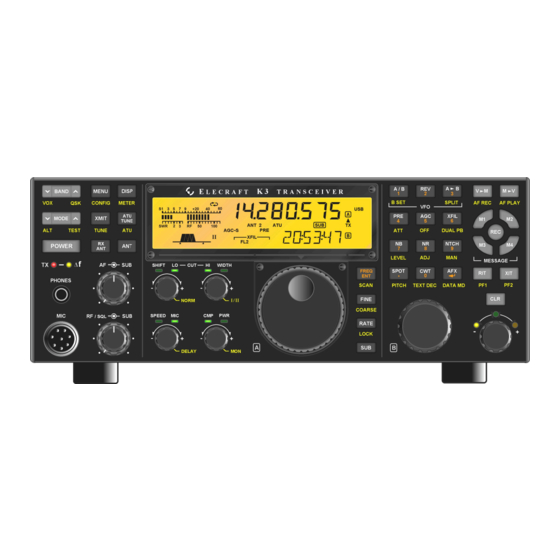
ELECRAFT K3 Installation Instructions Manual
High-performance 160-6 meter transceiver
Hide thumbs
Also See for K3:
- Assembly manual (84 pages) ,
- Owner's manual (82 pages) ,
- Installation and operation manual (55 pages)
Summary of Contents for ELECRAFT K3
- Page 1 ® LECRAFT 160 – 6 M ERFORMANCE ETER RANSCEIVER KAT3 100-W UTOMATIC NTENNA UNER NSTALLATION NSTRUCTIONS Rev B1, October 22, 2007 Copyright © 2007, Elecraft, Inc. All Rights Reserved...
-
Page 2: Table Of Contents
Contents Introduction............................... 3 Customer Service and Support..........................3 Technical Assistance ............................3 Repair / Alignment Service ..........................3 Preventing Electrostatic Discharge Damage .................... 4 How ESD Damage Occurs..........................4 Preventing ESD Damage............................. 4 Preparing for Installation .......................... 5 Tools Required ..............................5 Parts Included.............................. -
Page 3: Introduction
Repair / Alignment Service (We want to make sure everyone succeeds!) If necessary, you may return your Elecraft product to us for repair or alignment. (Note: We offer unlimited email and phone support to get your kit running, so please try that route first as we can usually help you find the problem quickly.) -
Page 4: Preventing Electrostatic Discharge Damage
How ESD Damage Occurs Whenever an object containing a static charge touches a circuit in your K3, current will rush into the circuit until the components reach the same voltage as the source of the static charge. If the voltage or current that passes through a component during that brief period exceeds its normal operating specifications, it may be damaged or destroyed. -
Page 5: Preparing For Installation
• If you choose to use a soldering iron to work on your K3 for any reason, be sure your iron has an ESD- safe grounded tip tied to the same common ground used by your mat or wrist strap. -
Page 6: Parts Included
Parts Included The following parts should be included in your kit. Check to ensure you have them all. If any parts are damaged or missing, contact Elecraft for replacements (see Customer Service and Support, page 3). ELECRAFT ILLUSTRATION DESCRIPTION QTY. -
Page 7: Installation Procedure
CAUTION: Touch an unpainted metal ground or wear a grounded wrist strap before touching components or circuit boards inside the K3. See Preventing ESD Damage on page 4 for more information. Remove the hardware securing the heat sinks of U13 and U12 to the right side panel (see Figure 2). Be careful not to lose the lock washers inside the K3. - Page 8 SO239 antenna connector shown in Figure 3. Do not lose the lock washer inside the K3. It is easier to keep the hardware from falling inside if you set the K3 on its side feet and remove the screw and lock washer holding the KANT3 board first, then set it on its bottom feet and remove the flat head screw from the 2D fastener.
- Page 9 Install the SO239 coaxial connector in the ANT2 space using the hardware shown in Figure 6. As you install components and reassemble your K3, be sure all the screws are in place and secure, but do not over tighten them. Failure to tighten all screws may result in poor shielding of sensitive components, resulting in possible noise or birdies in the receiver as well as other difficult-to-trace problems.
- Page 10 U13 and U12 to the side panel as shown in Figure 2. Hold the top cover above the K3 and plug the speaker wire into P25 on the KIO3 board at the left rear of the K3 as shown in Figure 8.
- Page 11 Position the top cover on the K3. Note that the tab on the back center goes under the rear lip of the K3 rear panel. Secure the top cover with the nine 4-40 3/16” (4.8 mm) black flat head screws you removed earlier.

















Need help?
Do you have a question about the K3 and is the answer not in the manual?
Questions and answers